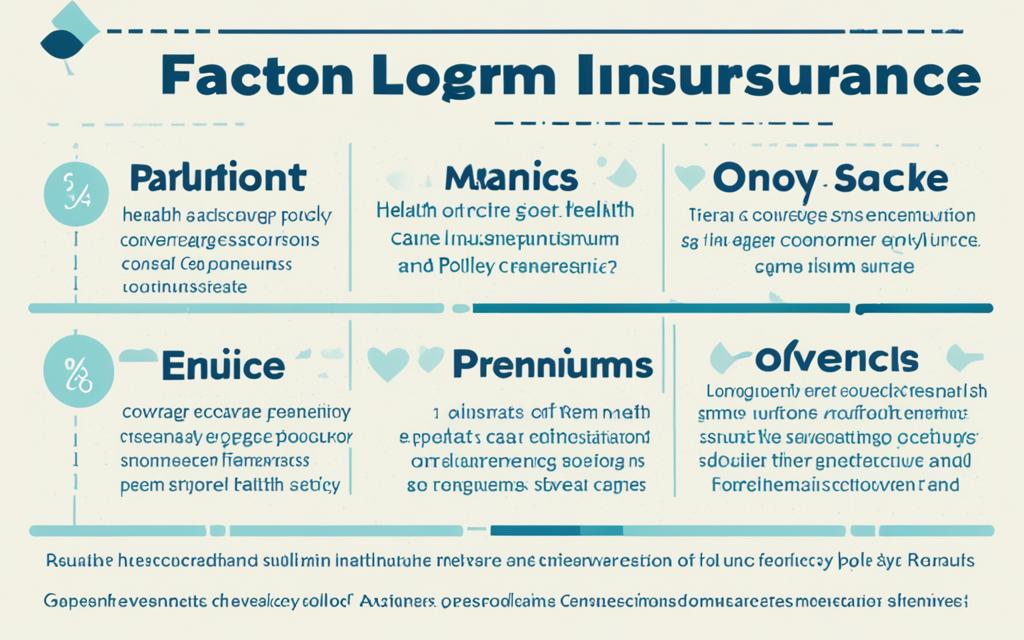- 1. What is Long-Term Care Insurance?
- 2. Understanding Long-Term Care
- 3. Why Do People Need Long-Term Care Insurance?
- 4. Long-Term Care Insurance vs. Traditional Health Insurance
- 5. The Rising Need for Long-Term Care Insurance
- 6. Types of Long-Term Care Services Covered
- 7. Key Features of Long-Term Care Insurance Policies
- 8. Long-Term Care Insurance
- 9. Factors Affecting Long-Term Care Insurance Premiums
- 10. Tax Advantages of Long-Term Care Insurance
- 11. Conclusion
- 12. FAQ
- 12.1 What is long-term care insurance?
- 12.2 What are the main types of long-term care insurance policies?
- 12.3 What is the purpose of long-term care?
- 12.4 Why do people need long-term care insurance?
- 12.5 How is long-term care insurance different from traditional health insurance?
- 12.6 What factors are contributing to the rising need for long-term care insurance?
- 12.7 What types of long-term care services are typically covered?
- 12.8 What are the key features to consider when evaluating long-term care insurance policies?
- 12.9 What factors can influence the premiums of long-term care insurance policies?
- 12.10 What tax advantages are available with long-term care insurance?
- 13. Source Links
As life expectancy continues to rise, the need for long-term care insurance has become increasingly important. This crucial financial tool provides coverage for a wide range of services, including home care, assisted living facilities, and nursing homes. By investing in a long-term care insurance policy, you can protect your retirement savings, maintain your independence, and lighten the burden on your family.
This comprehensive article will explore the various benefits of long-term care insurance and how it can help you secure your future. From elderly care coverage to nursing home protection and chronic illness policies, we’ll dive into the reasons why long-term care insurance is a crucial component of financial planning for aging.
Key Takeaways
- Long-term care insurance provides comprehensive coverage for a range of long-term care services, including home care, assisted living, and nursing home care.
- It can help protect your retirement savings and maintain your independence as you age.
- Long-term care insurance can lighten the burden on your family by covering the costs of your care.
- As life expectancy rises and healthcare costs escalate, the need for long-term care insurance has become increasingly important.
- Investing in a long-term care insurance policy can provide you with peace of mind and financial security for the future.
What is Long-Term Care Insurance?
Long-term care insurance is a type of insurance that covers the costs associated with long-term care services, such as nursing home care, assisted living facilities, and home health care. This type of insurance can play a crucial role in safeguarding an individual’s financial future and ensuring they have access to the necessary care and support as they age.
Nursing Facility and Residential Care Facility Only Policies
These policies provide coverage specifically for care received in a nursing home or residential care facility. They do not cover home health care or other community-based services. Nursing facility and residential care facility policies can be a more affordable option for individuals who are primarily concerned about the cost of nursing home care.
Home Care Only Policies
As the name suggests, home care only policies focus on covering the costs of in-home care services, such as personal care, homemaking, and skilled nursing. These policies are designed for individuals who wish to remain in their homes for as long as possible and receive the necessary care and assistance there.
Comprehensive Long-Term Care Policies
Comprehensive long-term care policies provide the broadest coverage, offering benefits for a wide range of services, including nursing home care, assisted living, and home health care. These policies are designed to provide a more holistic approach to long-term care, allowing policyholders to access the services they need, regardless of the setting.
The California Partnership for Long-Term Care
The California Partnership for Long-Term Care is a program that offers special long-term care insurance policies that provide additional asset protection. These policies are designed to help individuals prepare for their long-term care needs while also preserving their assets and potentially qualifying for Medi-Cal (Medicaid) coverage if their policy benefits are exhausted.
Understanding Long-Term Care
Long-term care refers to the assistance or supervision that individuals may need when they are unable to perform some of the basic “activities of daily living” (ADLs), such as eating, continence, bathing, dressing, or moving from a bed to a chair. This type of care is often required due to chronic medical conditions, mental deterioration, or the natural effects of aging.
Definition and Purpose of Long-Term Care
Long-term care encompasses a wide range of services and support that individuals may require when they can no longer independently manage their own daily living activities. The primary purpose of long-term care is to help maintain the individual’s quality of life, promote independence, and provide the necessary assistance to ensure their safety and well-being.
Activities of Daily Living (ADLs)
ADLs are the basic self-care tasks that individuals typically perform on a daily basis. These include eating, bathing, dressing, continence, toileting, and transferring (such as moving from a bed to a chair). An individual’s inability to perform one or more of these activities often triggers the need for long-term care services.
Types of Long-Term Care Services
The long-term care industry offers a variety of services to meet the diverse needs of individuals. These include home care, assisted living facilities, and nursing homes. Home care allows individuals to receive assistance with ADLs and other daily tasks within the comfort of their own homes, while assisted living facilities provide a more structured environment with on-site support and supervision. Nursing homes offer the highest level of long-term care, providing 24-hour medical and personal care for those with more complex needs.

Why Do People Need Long-Term Care Insurance?
As life expectancy continues to rise, the need for long-term care insurance has become increasingly important. With the potential to live longer, many individuals face the possibility of requiring extended healthcare services, such as home care, assisted living, or nursing home care. Long-term care insurance can play a crucial role in protecting an individual’s retirement savings, maintaining independence, and lightening the burden on their family.
Increasing Life Expectancy
The average life expectancy in the United States has steadily increased over the past several decades, with many individuals now living well into their 80s and 90s. This extended lifespan, while a positive development, also means that the need for long-term care services is on the rise. Long-term care insurance can help ensure that individuals have the necessary resources to cover the costs of care as they age, allowing them to maintain their quality of life and avoid depleting their hard-earned retirement savings.
Protecting Retirement Savings
The costs associated with long-term care can be substantial, often exceeding the financial capabilities of many retirees. Long-term care insurance can help protect an individual’s retirement savings by covering the expenses of extended healthcare services, preventing the need to dip into their hard-earned nest egg. This can be especially important for those who have worked diligently to build a comfortable retirement, as it allows them to preserve their financial resources and maintain their independence for as long as possible.
Maintaining Independence
Long-term care insurance can help individuals maintain their independence by providing access to the necessary care and support services, enabling them to remain in their homes or communities for as long as feasible. This can be particularly valuable for those who wish to avoid the transition to a nursing home or assisted living facility, as it allows them to retain a sense of autonomy and control over their daily lives.
Lightening the Burden on Family
When individuals require long-term care, the burden often falls on their family members, who may need to take on the role of caregivers or coordinate the necessary services. Long-term care insurance can help lighten this burden by providing financial resources and access to professional care providers, allowing family members to focus on supporting their loved ones emotionally and practically, rather than being solely responsible for the logistical and financial aspects of their care.
Long-Term Care Insurance vs. Traditional Health Insurance
When it comes to healthcare coverage, long-term care insurance and traditional health insurance serve distinct purposes. While traditional health insurance focuses on treating and curing illnesses, long-term care insurance is specifically designed to cover long-term services and support, such as personal and custodial care.
The key differences between long-term care insurance and traditional health insurance lie in the scope of coverage. Traditional health insurance typically pays for medical expenses related to acute or short-term care, such as doctor visits, hospital stays, and prescription drugs. In contrast, long-term care insurance provides coverage for a wide range of long-term care services, including in-home care, assisted living, and nursing home care.
| Feature | Long-Term Care Insurance | Traditional Health Insurance |
|---|---|---|
| Primary Focus | Long-term services and support | Treating and curing illnesses |
| Covered Services | Personal and custodial care, home care, assisted living, nursing home | Doctor visits, hospital stays, prescription drugs |
| Eligibility Criteria | Inability to perform activities of daily living or cognitive impairment | Acute or short-term medical conditions |
| Benefit Triggers | Requiring assistance with activities of daily living or cognitive impairment | Medical necessity and physician’s orders |
Understanding the differences between long-term care insurance and traditional health insurance is crucial when evaluating your coverage needs and ensuring you have the appropriate financial protection in place for your long-term care requirements.

The Rising Need for Long-Term Care Insurance
As the population continues to age and life expectancy increases, the demand for long-term care services has surged, highlighting the growing need for comprehensive long-term care insurance. This rising need can be attributed to several key factors:
Demographic Shifts and Aging Population
The United States is experiencing a significant demographic shift, with the aging population rapidly expanding. By 2030, it is estimated that over 70 million Americans will be 65 or older, nearly doubling the number from 2010. This aging population will require an increasing amount of long-term care services, further underscoring the rising need for long-term care insurance.
Escalating Healthcare Costs
The cost of healthcare, including long-term care services, has been steadily rising, putting a significant strain on both individuals and the healthcare system. The average annual cost of a private room in a nursing home is now over $100,000, and the cost of home health care can also be substantial. This escalating healthcare cost landscape highlights the importance of long-term care insurance as a means of protecting personal finances and ensuring access to quality care.
Limited Government Assistance
While government programs like Medicaid provide some assistance for long-term care, the eligibility requirements and coverage limitations can leave many individuals and families with significant out-of-pocket expenses. With limited government assistance available, the need for long-term care insurance becomes even more pressing, as it can help bridge the gap and provide the necessary coverage for long-term care services.
In the face of these demographic shifts, rising healthcare costs, and limited government support, the need for long-term care insurance has become increasingly crucial. By investing in a comprehensive long-term care insurance policy, individuals can ensure their financial security and access to high-quality care as they age, ultimately providing peace of mind and a more secure future.
Types of Long-Term Care Services Covered
Long-term care insurance policies typically cover a range of services to support individuals who require assistance with activities of daily living (ADLs) or have chronic medical conditions. These services can include the following:
Home Care
Home care services, such as skilled nursing, personal care, and homemaking, allow individuals to receive the care they need in the comfort of their own homes. Long-term care insurance can cover the costs associated with in-home care, enabling policyholders to maintain their independence and familiar surroundings for as long as possible.
Assisted Living Facilities
Assisted living facilities provide a middle ground between independent living and nursing home care. These communities offer 24-hour supervision, assistance with ADLs, and various amenities to support residents’ well-being. Long-term care insurance can help cover the expenses of assisted living, ensuring policyholders have access to the appropriate level of care as their needs change over time.
Nursing Homes
Nursing homes provide the highest level of long-term care, offering round-the-clock medical and personal care for individuals who require extensive assistance with ADLs or have complex health conditions. Long-term care insurance can help offset the significant costs associated with nursing home care, protecting policyholders’ financial assets and ensuring they receive the necessary level of care.
By covering a wide range of long-term care services, including home care, assisted living facilities, and nursing homes, long-term care insurance helps individuals and their families plan for and access the appropriate care as their needs evolve. This comprehensive coverage can provide peace of mind and financial security during a critical time in one’s life.
Key Features of Long-Term Care Insurance Policies
When evaluating long-term care insurance policy features, there are several key elements to consider. These include the elimination period, daily benefit amount, and inflation protection. Understanding these features can help you select a policy that aligns with your specific needs and financial circumstances.
Elimination Period
The elimination period refers to the number of days you must pay for long-term care services out-of-pocket before your insurance policy begins to provide coverage. Elimination periods can range from 0 to 180 days, with longer elimination periods typically resulting in lower premiums. However, it’s essential to carefully evaluate your financial resources and determine an elimination period that balances affordability and adequate coverage.
Daily Benefit Amount
The daily benefit amount is the maximum amount your insurance policy will pay per day for your long-term care services. This amount can range from $50 to $500 or more, depending on the policy. It’s important to consider the average cost of long-term care in your area and choose a daily benefit amount that can cover a significant portion of those expenses.
Inflation Protection
Given the rising costs of healthcare and long-term care services, inflation protection is a crucial feature to consider. This feature allows your daily benefit amount to increase over time, ensuring that your coverage keeps pace with the rising costs of care. Policies with inflation protection can offer greater long-term value and financial security as you age.
| Feature | Description | Importance |
|---|---|---|
| Elimination Period | The number of days you must pay for long-term care services out-of-pocket before your insurance policy begins to provide coverage. | Balances affordability and adequate coverage. |
| Daily Benefit Amount | The maximum amount your insurance policy will pay per day for your long-term care services. | Covers a significant portion of the average cost of long-term care in your area. |
| Inflation Protection | Allows your daily benefit amount to increase over time, keeping pace with the rising costs of care. | Provides greater long-term value and financial security as you age. |

Long-Term Care Insurance
Long-term care insurance is a financial product that provides coverage for a wide range of long-term care services, including home care, assisted living facilities, and nursing homes. This type of insurance can play a critical role in safeguarding an individual’s financial future and ensuring they have access to the necessary care and support as they age.
As long-term care insurance becomes increasingly important in the face of rising life expectancy and escalating healthcare costs, this financial tool can help protect retirement savings, maintain independence, and alleviate the burden on family members. By investing in a comprehensive long-term care insurance policy, individuals can enjoy peace of mind and secure their financial well-being for the long term.
The coverage provided by long-term care insurance can vary, with policies typically offering a range of services, such as in-home care, assisted living accommodations, and skilled nursing facility care. These policies can be tailored to meet the specific needs and preferences of the policyholder, ensuring they receive the appropriate level of care as their health and mobility needs change over time.
One of the key benefits of long-term care insurance is its ability to preserve personal assets and safeguard retirement funds. Without this type of coverage, the costs of long-term care can quickly deplete an individual’s savings, leaving them vulnerable and dependent on government assistance programs like Medicaid. By investing in a long-term care insurance policy, individuals can protect their financial future and maintain control over their care decisions.
| Key Features of Long-Term Care Insurance | Benefits |
|---|---|
| Comprehensive Coverage | Provides protection for a wide range of long-term care services, including home care, assisted living, and nursing home care. |
| Customizable Policies | Allows individuals to tailor the coverage to meet their specific needs and preferences, including the daily benefit amount and coverage duration. |
| Inflation Protection | Helps ensure that the policy’s benefits keep pace with the rising costs of long-term care services over time. |
| Tax Advantages | Offers potential federal and state tax deductions or credits, making the policy more affordable for many individuals. |
By understanding the benefits and features of long-term care insurance, individuals can make informed decisions about protecting their financial future and ensuring they have access to the care they need as they age. This type of insurance can provide a valuable safety net and give peace of mind to both the policyholder and their loved ones.
Factors Affecting Long-Term Care Insurance Premiums
When considering long-term care insurance, it’s important to understand the various factors that can influence the premiums you’ll pay. Three key elements that often impact the cost of your policy are your age, your health status, and the coverage options you select.
Age
One of the primary factors affecting long-term care insurance premiums is your age. Generally, the younger you are when you purchase a policy, the lower your premiums will be. This is because younger individuals are statistically less likely to require long-term care services in the immediate future, resulting in a lower risk profile for insurance providers.
Health Status
Your current health status is another significant factor that insurers consider when setting long-term care insurance premiums. Individuals with pre-existing medical conditions or a history of chronic illnesses may be required to pay higher premiums, as they present a greater risk of needing long-term care services in the years to come.
Coverage Options
The specific coverage options you choose for your long-term care insurance policy can also impact the premiums you’ll pay. Factors such as the daily benefit amount, the length of the coverage period, and the inclusion of inflation protection can all influence the overall cost of your policy.
By understanding these key factors, you can work closely with your insurance provider to find a long-term care insurance plan that provides the coverage you need at a premium that fits your budget.

Tax Advantages of Long-Term Care Insurance
Investing in a long-term care insurance policy can provide individuals and families with a range of valuable tax advantages, making it an even more appealing option for planning their long-term care needs.
Federal Tax Deductions
One of the primary tax benefits of long-term care insurance is the ability to deduct a portion of the premiums paid from your federal income taxes. The deductible amount is based on your age, with older individuals able to deduct a higher percentage of their premiums. This federal tax deduction can significantly offset the cost of maintaining a long-term care insurance policy, making it a more accessible and affordable choice for many Americans.
State Tax Incentives
In addition to the federal tax deductions, several states also offer their own state tax incentives for individuals who purchase long-term care insurance. These incentives can take the form of tax credits, deductions, or other financial benefits that further enhance the tax advantages of long-term care insurance. By taking advantage of both federal and state-level tax benefits, policyholders can maximize the overall financial value of their long-term care insurance investment.
By leveraging the various tax advantages associated with long-term care insurance, individuals and families can better prepare for their future long-term care needs while also optimizing their financial planning and tax strategies. This comprehensive approach can provide greater peace of mind and financial security as they navigate the challenges of aging and potential healthcare requirements.
Conclusion
In conclusion, long-term care insurance is a crucial financial tool that can provide comprehensive benefits and secure a person’s future. As life expectancy continues to rise and healthcare costs escalate, the need for long-term care services has become increasingly important.
By investing in a long-term care insurance policy, individuals can protect their retirement savings, maintain their independence, and lighten the burden on their loved ones. These policies cover a wide range of services, including home care, assisted living facilities, and nursing homes, ensuring that policyholders have access to the care they need as they age.
As the population continues to age and the demand for long-term care services grows, long-term care insurance has become an essential component of comprehensive financial planning. Whether you’re looking to safeguard your own future or provide for a loved one, this valuable coverage can offer peace of mind and financial security in the years to come.
FAQ
What is long-term care insurance?
Long-term care insurance is a type of insurance that covers the costs associated with long-term care services, such as nursing home care, assisted living facilities, and home care.
What are the main types of long-term care insurance policies?
There are three main types of long-term care insurance policies: long-term care facility only policies, home care only policies, and comprehensive long-term care policies.
What is the purpose of long-term care?
Long-term care refers to the assistance or supervision that individuals may need when they are unable to perform some of the basic “activities of daily living” (ADLs), such as eating, continence, bathing, dressing, or moving from a bed to a chair. This type of care is often required due to chronic medical conditions, mental deterioration, or the natural effects of aging.
Why do people need long-term care insurance?
People need long-term care insurance for several key reasons, including increasing life expectancy, protecting retirement savings, maintaining independence, and lightening the burden on their family.
How is long-term care insurance different from traditional health insurance?
Long-term care insurance differs from traditional health insurance in several key ways. While traditional health insurance focuses on treating and curing illnesses, long-term care insurance is specifically designed to cover long-term services and support, such as personal and custodial care.
What factors are contributing to the rising need for long-term care insurance?
The need for long-term care insurance is on the rise due to several key factors, including demographic shifts and an aging population, escalating healthcare costs, and limited government assistance.
What types of long-term care services are typically covered?
Long-term care insurance policies typically cover a range of long-term care services, including home care, assisted living facilities, and nursing homes.
What are the key features to consider when evaluating long-term care insurance policies?
When evaluating long-term care insurance policies, there are several key features to consider, such as the elimination period, daily benefit amount, and inflation protection.
What factors can influence the premiums of long-term care insurance policies?
Several key factors can influence the premiums of long-term care insurance policies, including the policyholder’s age, health status, and the coverage options selected.
What tax advantages are available with long-term care insurance?
Long-term care insurance policies can offer various tax advantages, such as federal tax deductions and state tax incentives, which can make them an even more attractive option for individuals and families planning for their long-term care needs.
Source Links
- https://www.insurance.ca.gov/01-consumers/105-type/95-guides/05-health/01-ltc/ltc-insurance.cfm
- https://facet.com/insurance-planning/comprehensive-guide-to-long-term-care-insurance-coverage-costs-tax-advantages-explained/
- https://www.linkedin.com/pulse/importance-long-term-care-insurance-planning-secure-future-depano-m4kaf
